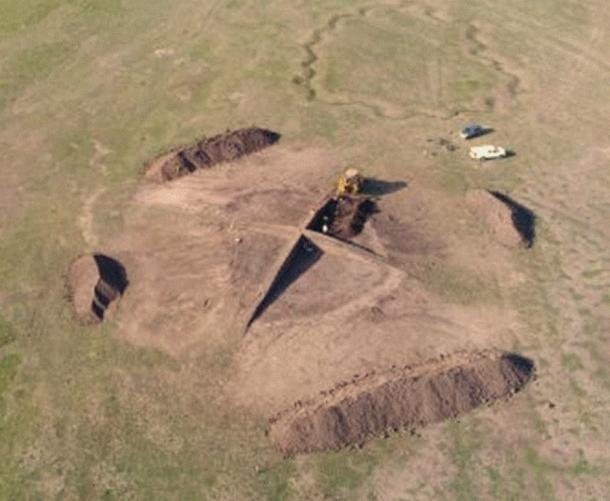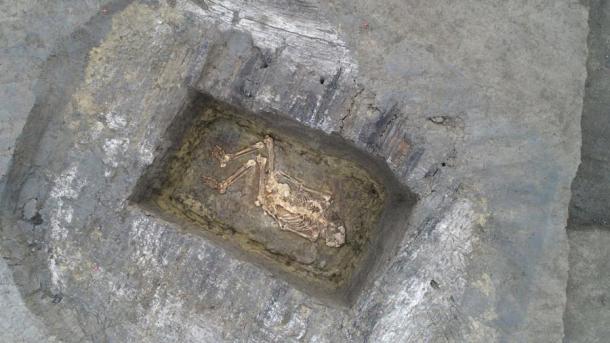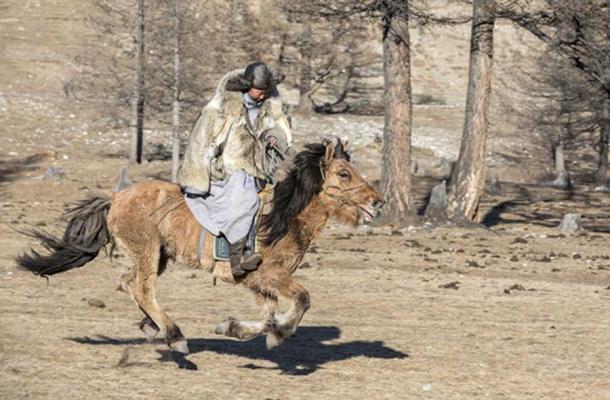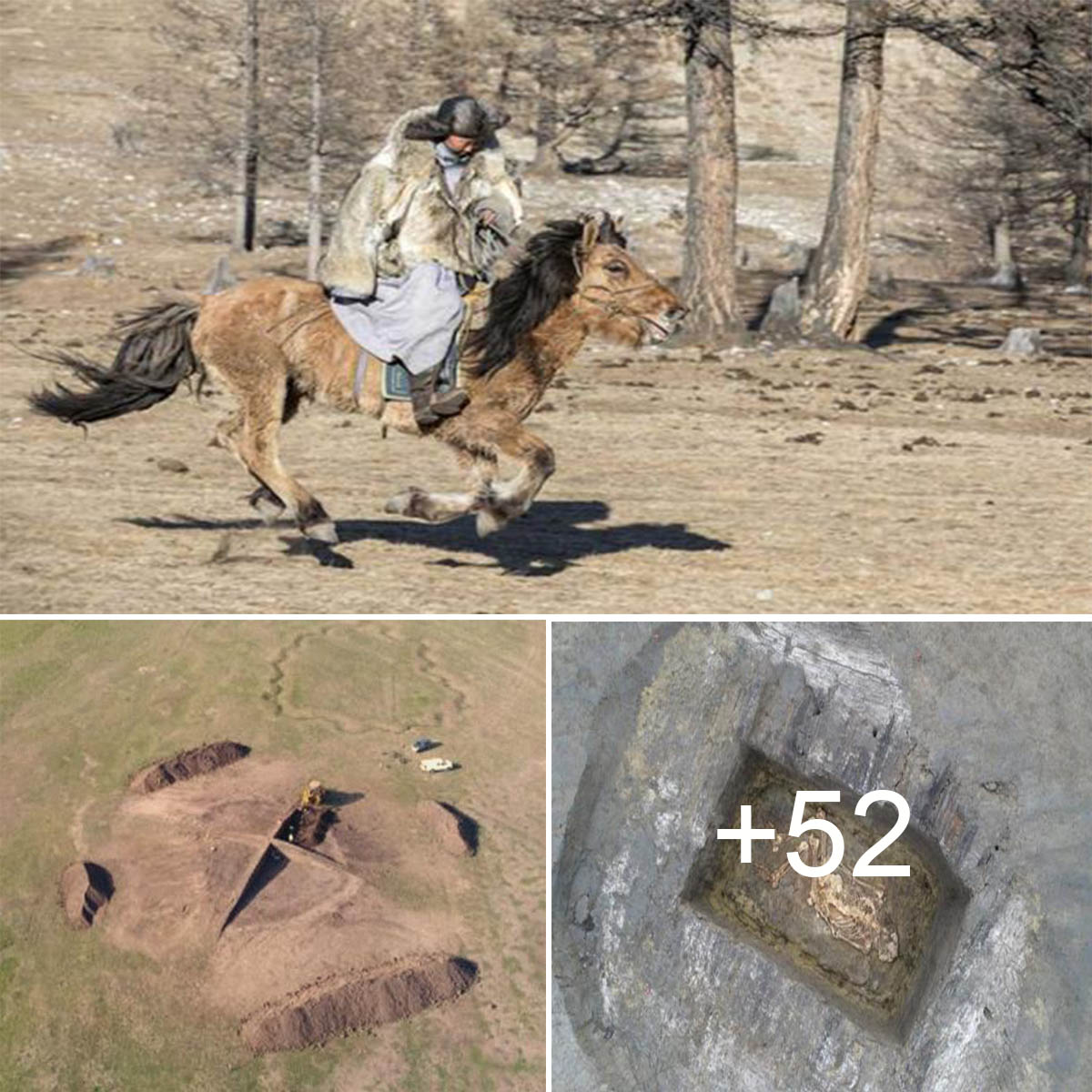Burial Mounds in Serbia Reveal Skeletons of 5,000-Year-Old Painted Men
Entombed inside two large barrows (burial mounds) located on an open plain in northern Serbia, a team of scientists from the Institute of Archaeology and Ethnology of the Polish Academy of Sciences (IAEPA N) found some highly anomalous skeletons. The men in these burial mounds were of significant height, and the bones of each had been painted over with red ochre dye made from the clay of the earth.
Based on their extensive study of these remains, the IAEPA N archaeologists have determined that the men lived and died nearly 5,000 years ago and had likely belonged to a group of immigrants who arrived in ancient Serbia from the steppes of southern Russia and the Ukraine.
One of the two barrow burial mounds investigated in Serbia, where the strange painted immigrant men from the “northeast” were unearthed.
Sacred Burial Mounds of Immigrants from the Northeast?
The mounds and their eye-opening contents were discovered in the autonomous district of Vojvodina, in Serbia’s Šajkaška region near the lower Tisza River. This location is at the western edge of the greater Eurasian steppe, making it a logical destination for nomadic groups migrating across the open landscapes from the northeast.
As prominent landmarks on an otherwise undistinguished landscape, the two large barrow burial mounds are an impressive sight to behold. Both are about 130 feet (40 meters) in diameter and approximately 12 feet (3-4 meters) high, which means they tower over a person standing beside them.
As for the skeletal remains, the first bodies were buried inside the mounds sometime between 3,000 and 2,900 BC, while the second burial took place about 100-200 years later. At the time of the second burial the size of the burial mounds was increased dramatically, and they remained preserved in that larger form from that point on.
While the burial chambers inside each mound were quite expansive, their design was basic. Grave goods were noticeably lacking, which in normal circumstances would be taken to mean the people buried there were not wealthy or powerful.
The archaeologists found this classic Yamnaya style burial in the Serbian burial mound, and from there reconstructed what these people would have looked like. (P. Wlodarczak / PAP
“The graves we discovered were not spectacularly furnished,” expedition leader Dr. Piotr Włodarczak confirmed in an interview with the Polish news service PAP. “But the red color of some of the bones attracted attention. This was due to the use of ochre to cover, or possibly color, the bodies of the dead.”
It is known that red was a sacred color among some groups of people who lived in Europe 5,000 years ago, including those that came from the steppes of far eastern Europe and southcentral Asia. As a result, ochre paint was frequently used during ceremonies or rituals designed to honor or protect the dead.
In addition to the red paint on their bones, the other factor that stood out about the men in the barrows was their size. These individuals were more than six feet (1.8 meters) tall, a height that in Bronze Age times was rarely reached by the normal European.
This startling fact could best be explained by a foreign origin for these men, the Polish researchers concluded.
“Both the use of ochre and the above-average height of the deceased—men living in this part of Europe at the turn of the 4th and 3rd millennia usually reached about 1.6 meters—indicate that the dead were immigrants,” Dr. Włodarczak said. “The ritual with the use of ochre and placing individual burials in large mounds is associated with communities living in the eastern European steppe areas.”Genetic analysis on the remains recovered from the Serbian tombs has verified that the men were either immigrants from the east, or directly descended from others who’d made the trek from the Ukraine/southern Russia area. More fascinating data was found as a result of isotopic analysis performed on the bones, which helped determine certain facts about the way the men had lived.
It was revealed, for example, that they’d been heavy consumers of meat .
“It was no surprise to us that the deceased consumed a lot of meat, as these communities were involved in livestock farming,” Dr. Włodarczak explained.
The Yamnaya culture entered Europe via Russia or the Ukraine, but evidently some also discovered Serbia on their travels. ( katiekk2 / Adobe Stock)
The Yamnaya Culture in Eastern Europe
So, who exactly were the tall, meat-eating immigrants from the east who left behind the burial mounds filled with ochre-covered skeletons in Serbia?
According to Dr. Włodarczak, they were members of the Yamnaya culture.
The Yamnaya people were a late Copper Age-to-early Bronze Age population that emerged as a distinct ethnic identity between 3,000 and 2,600 BC. They were native to the Pontic-Caspian steppe , a huge area of treeless grassland plains that extended from the northern shores of the Black Sea to the region north of the Caspian Sea. This vast stretch of steppeland covered more than 384,000 square miles (994,000 square kilometers) of territory and included large parts of what today are the Ukraine and southern Russia.
The Yamnaya people came from the vicinity of the Ural River in Russia, which is located on the eastern half or Pontic section of the steppe.
In their homeland, the Yamnaya were a nomadic people who managed large herds of animals. The groups of migrants who made their way to eastern Europe would have transitioned to a more settled lifestyle, as access to open land for grazing would have been limited.
Interestingly, the Yamnaya name was derived from the Russian word ‘yama,’ which translated means ‘related to pits.’ In this case the pits actually refer to the underground pit chambers (known as kurgans) that the Yamnaya people would dig to bury their dead.
For the most part, the Yamnaya retained their most important cultural practices after arriving in Europe.
“Proto-state centers of the Bronze Age began to emerge and the elites were separated, as evidenced, for example, by large burial mounds where individuals were buried,” Dr. Włodarczak explained, detailing Yamnaya practices in the west.
Some of the Yamnaya tombs found over the years have included rich collections of weapons, fine ornaments, decorated pottery vessels, and other burial goods consistent with tombs reserved for elites. The barrows discovered in Vojvodina are the westernmost Yamnaya tombs that have been found, and while the men buried there were apparently not elites, they were still respected enough to be given a proper send-off, decorated in a sacred red color that would keep them safe and sound as they crossed the boundary to the next world.
Hits: 0





